Thomas J. F. Goreau, PhD
President, Global Coral Reef Alliance
Introduction: Bahamas coral reef deterioration
This study is thought the first ever to evaluate the health of coral reef ecosystems and fisheries before and after a golf course development. The same results could certainly have been found at any other golf course near the shore. It confirms that coastal developments, in order not to harm marine ecosystems and fisheries, must not release nutrient rich runoff into the sea. There are now more than a dozen golf courses in the Bahamas, with many more in planning stages.
Bahamas coral reefs were famous for huge corals, high coral cover, and vast fish populations, so most of the first high quality underwater photos were taken there. Once-magnificent Bahamian coral reefs have deteriorated so much that only the very oldest divers might remember them. The vast majority of corals have died from a combination of factors including global warming, new diseases, land-based sources of pollution, dredging, deforestation, and destructive fishing methods.
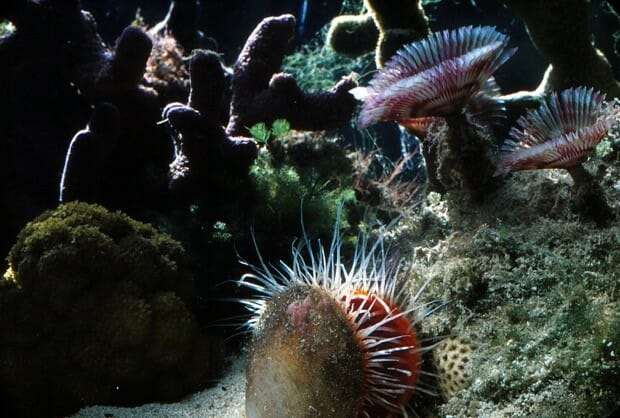
The first good underwater photographs were taken in the Bahamas in 1948 by Fritz Goreau
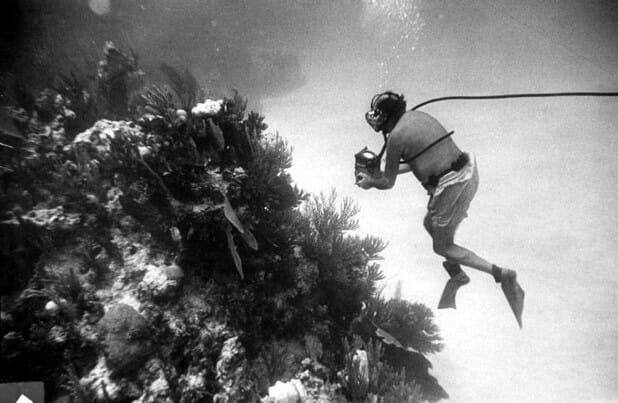
Fritz Goreau photographing in the Bahamas, photo by Thomas F. Goreau, 1948
Most Bahamian waters are composed of very shallow banks with only small patch reefs because poor water circulation makes the water too hot for corals in the summer, so the best reefs were located on the eastern fringe of the archipelago, which drops off very deep, and is bathed in cool food-rich Atlantic waters. The outer reefs of Abaco were especially healthy, and the shallow reef had huge coral formations that had grown so rapidly that the reef crest was riddled with unusual caves and passages underneath it, roofed over with living corals.
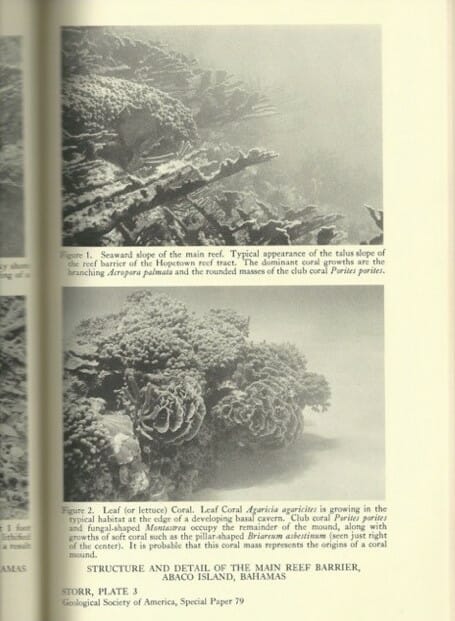
Abaco reefs (Storr, 1964)
Reef deterioration in the Bahamas is worst down-current from the most heavily populated islands, Nassau, New Providence and Freeport, Grand Bahama. This follows a global pattern of deteriorating water quality around all populated coasts due to physical disturbances such as dredging for cruise ship piers and for landfill, and land-based runoff of sewage, fertilizers, nutrients, toxic pollutants, and disease-causing pathogens. The most widespread deterioration of marine ecosystems and fisheries along coastal areas is usually blamed on overfishing, but in fact most of it is caused by habitat deterioration due to the prolific growth of harmful algae blooms. These are over-fertilized with sewage and fertilizer nutrients flowing into the sea via groundwater, rivers, and canals, causing reef corals to be smothered and killed by massive growth of algae.
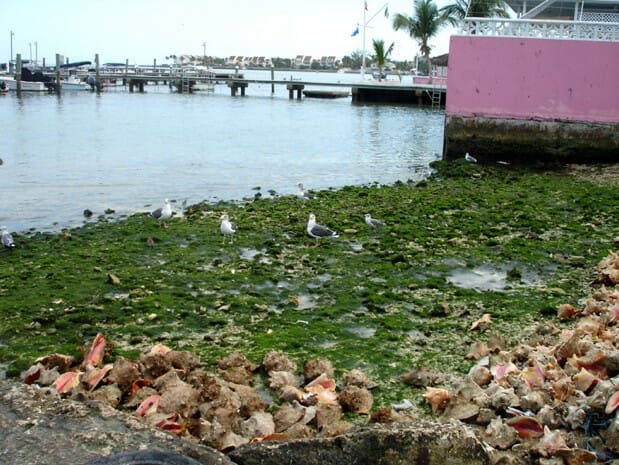
Nassau waterfront is overgrown with slimy weedy algae that indicate very high levels of sewage nutrients. Remnants of conch overfishing litters the shore
Healthy coral reefs are Nature’s finest coastal protection because they grow rapidly and grow back when damaged. Dead reefs still have some shore protection function, but because corals are no longer growing and able to repair the reef, the reef wave barrier is slowly crumbling due to the destructive action of boring organisms and will eventually collapse entirely in hurricane waves. In some parts of the Caribbean huge coastal reefs that used to reach the water surface have vanished without a trace, even the last trace of dead coral rubble is long gone in many places. Because of poorly planned coastal over-development, tourist beaches around the world have dead reefs in front of them, and hotels must take their guests far away to see live corals and fishes.
Despite these clear patterns of environmental deterioration, coastal developments are routinely approved with little or no environmental impact assessment on marine habitats, and when an EIA is required, the environmental consultants, who are paid directly by the developer, routinely state that no environmental impact will occur, usually without actually making any effort to assess the health of the marine ecosystem. There are hundreds of golf courses overlooking the ocean in coral reef environments, yet in no case was a competent EIA done that properly assessed marine ecosystem impacts of golf courses before and after development to see if the claims routinely made of “no harm” were in fact true. None even mentioned the strict nutrient water quality standards needed to protect coral reefs from harm.
Bakers Bay golf course development opposed by island’s fishermen
When a large golf course, villa, and mega-yacht marina was proposed for the northern end of Guana Cay, Abaco, Bahamas, local residents protested vociferously that they did not want it on their island because it would damage their coral reef and fisheries (https://www.notesfromtheroad.com/westindies/guana-cay-reef.html, https://www.notesfromtheroad.com/guana.htm). Guana Cay has been a traditional Bahamian fishing community since the 1700s, when they found the islands were too dry to grow enough food. They live from selling their catches to Nassau and hotels, so a healthy marine environment is their top priority.
The Guana Cay community objected that the development would destroy the mangroves and seagrass juvenile habitat for the fish, lobster, and conch they catch by dredging and by sediment runoff following land clearance. They said that golf courses used large amounts of fertilizers and poisonous pesticides and herbicides that would flow into the sea through groundwater and damage the water quality and health of the coral reefs, sea grasses, and fisheries, and that everyone knew fertilizers and sewage cause harmful algae blooms that overgrow and kill coral reefs. To their surprise they could not find a single golf course EIA that stated this very well-known truth, in fact all assessments denied it would or even could possibly happen at their site, as did the very expensive EIA the developers produced for the Guana Cay golf course project!
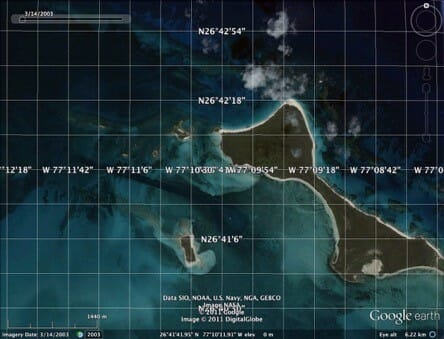
Before “development”, the Northwest half of Guana Cay had pristine coral reefs, mangroves, and seagrasses and was the basis of the Guana Cay fisheries
Guana Cay residents lived at the south east end of the island, and for hundreds of years had preserved the forests, mangroves, sea grasses, and reefs at the north west end untouched, because that was their fishing and nursery grounds. By Bahamian law the sale of Crown Land like this should be first to Bahamians, so they were shocked when the Bahamas Government gave half the island without warning to a foreign developer, and did so at giveaway prices, literally a “steal” without allowing the residents to make a claim. Guana Cay residents filed suit against the development, the case dragged on for years and was finally dismissed on a procedural technicality without addressing any issues of substantive environmental harm that would be expected to result from the project. Their island had been divided by a fence and they were not allowed to go the other exclusively private side.
The developers claimed that there would be many jobs for locals, but that did not happen. Managerial positions were all taken by foreigners, and Haitian labor was brought in for all construction. Haitian workers lived in tar-paper, tarpaulin, and corrugated iron shacks in The Mudd, a mangrove swamp in Marsh Harbour, where they died by thousands after Category 5 Hurricane Dorian arose without warning. Guana Cay fishermen lost all their homes and boats.
The developer, Discovery Land Company, hired a very expensive team from the University of Miami to write an EIA that would claim no harm, in fact great expense was made to bring in politicians to state this was a state-of-the-art “green” development. In the 2004 Bakers Bay Environmental Assessment and Management Plan, the developers’ highly paid consultants claimed that there would be NO adverse effects of Golf Course, sewage, construction, or erosion on water quality due to “advanced” waste water treatment, lining of golf courses to prevent leaching, and construction of buffer zones to prevent chemicals washing into sea. They promised “To maintain water quality parameters in coastal groundwater and near shore marine waters at pre-construction levels”, and to notify the community of the results of their own long-term water quality monitoring. No such information ever resulted.
Reef health before development
The islanders searched for top coral experts to independently assess the reef before any development or alteration of the land took place. Dr. Michael Risk studied the reef near the proposed development in 2004, Dr. James Cervino in 2006, 2007, and 2012, and Dr. Thomas J. F. Goreau in 2007, 2012, and since. All three coral researchers independently found these reefs were among the best remaining in the Bahamas in terms of coral cover, diversity, and health, and all found no sign of coral diseases or of weedy harmful algae blooms. All three concluded that these reefs were so close to the proposed golf course and marina development that they would inevitably be harmed. All three worked without pay in order to avoid bias.
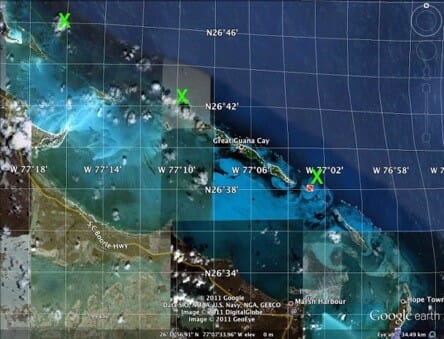
Coral reef health was studied next to the proposed development (central site) and at remote reefs up-current and down current. The general current flow is from Southeast to Northwest
Reef health after golf course development
After the Guana Cay suit was thrown out of court on procedural rather than substantive grounds, the developers proceeded to bulldoze the vegetation, dredge out mangroves for a mega-yacht marina, and dredge access channels through the shallow seagrass beds. Large amounts of mud from deforested land ran into the sea, with silt curtains having no effect as mud flowed over, under, and through them. Seagrass beds were smothered with silt from dredging. Fishermen noticed that their mangrove fish nursery, the basis of their fisheries, had collapsed. After the golf course went in, divers immediately began to notice that corals were starting for the first time to die from diseases, and for the first time, harmful algae blooms appeared on the reef and began to kill corals. Dr. Goreau and Cervino documented the changes in the algae and coral reef diseases in following years and found that these phenomena, which had not been present on the reef before the golf course was set up, suddenly appeared after the golf course and grew progressively worse.
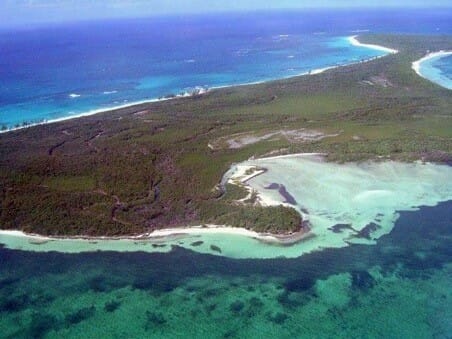
This mangrove lined bay was the major nursery for lobsters, conch, and fishes
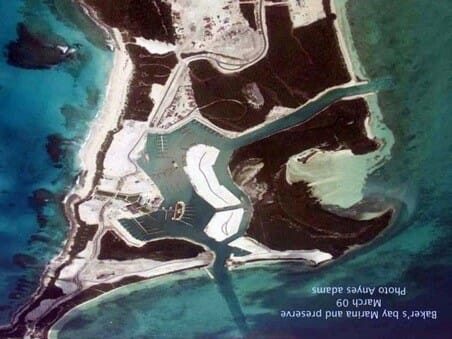
Afterwards, vegetation bulldozed, marina excavated in mangroves, channels dug through seagrass beds
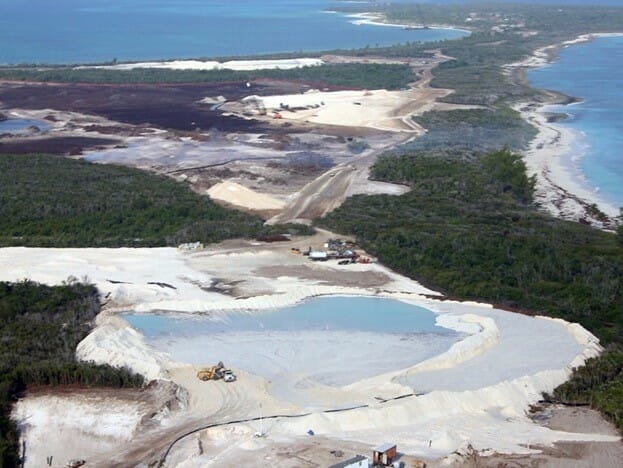
Land was dug out below the water table
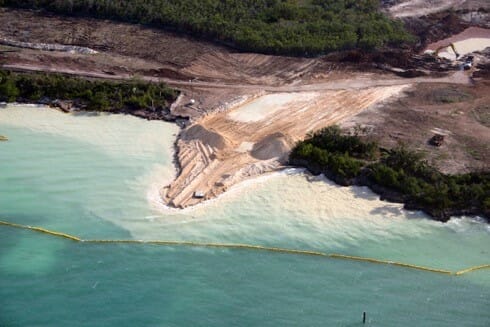
Silt curtains were used to prevent mud flowing into the sea, with no effect
Besides harmful algae appearing on the coral reef, masses of algae species that are known to be indicators of high nutrient pollution appeared for the first time on the beach rock along the shores near the golf course, and were most abundant where the irrigated and fertilized golf course runway greens were closest to the shore. The promised vegetation buffer zone between the golf course and the shore, whose roots were supposed to absorb groundwater nutrients before they could flow into the sea, was either uselessly narrow or absent and were not properly lined. Because so few of the promised original environmental planning guidelines such as buffer zones and impermeable linings, were in fact carried out, and because the promised long-term water quality monitoring program was not implemented, the Miami team who prepared the original EIA, environmental management plan, and had been hired to do the monitoring program, quit in disgust, but their silence has been bought, so they refuse to discuss what in fact happened at Bakers Bay.
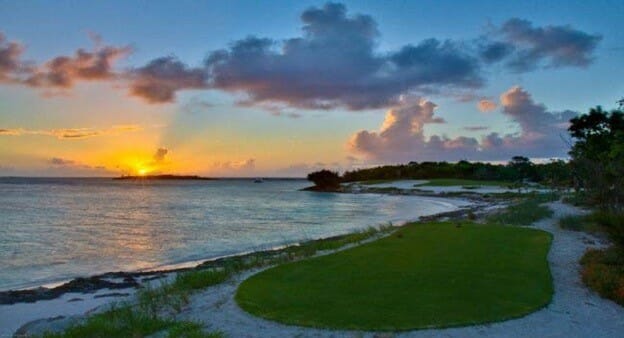
The golf course greens come down right to the beach, with little or no vegetated buffer zone to absorb nutrients in groundwater. Weedy algae are proliferating right in front
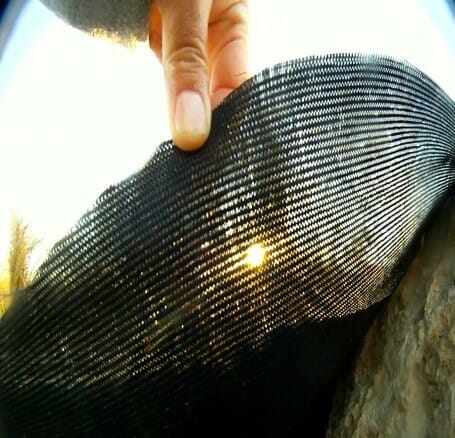
The morning sun shines right through the developer’s “impermeable barrier” at the seaward edge of the Bakers Bay golf course green. It retains soil but water and dissolved nutrients flow right through it
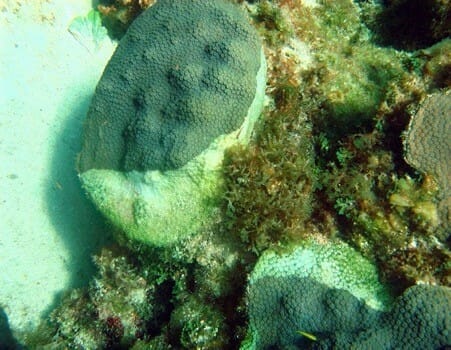
Soon after the golf course went in, corals on the nearby reef started to be overgrown by weedy algae and killed by coral diseases. In this slide White Plague Disease, not present before
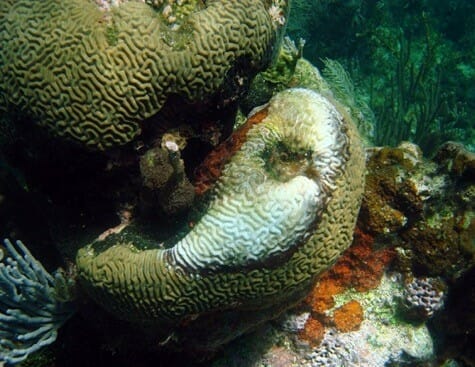
Coral near golf course being killed by Black Band Disease, not present before
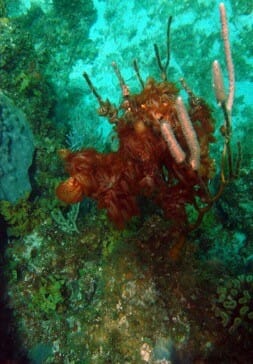
Soft coral near golf course being killed and overgrown by slimy cyanobacteria, an indicator of high nutrient pollution, extremely rare before
Algae nutrient source survey results
The critical nutrient concentrations above which algae smother and kill coral reefs is the lowest of any aquatic ecosystem, so to be safe coral reefs need the highest protection and lowest nutrient concentrations, with nitrogen less than 0.014 parts per million, and phosphorus less than 0.003 parts per million. Nutrients in the water vary very rapidly in space and time, making huge numbers of accurate analyses needed to measure environmental levels. In contrast, algae on the bottom integrate nutrient concentrations over their lifetime, and algae species are sharply zoned by both nitrogen and phosphorus concentrations. Because algae respond so rapidly to nutrients in terms of growth, rate, color, shape, and species abundance, they provide the best measures of water quality.
In order to determine the source of nutrients causing harmful algae blooms, algae were collected at many locations around the island, both near to and far away from the golf course and marina, and at remote reefs up-current and down-current from Guana Cay. These samples were analyzed for their carbon, nitrogen, and phosphorus contents, as well as the natural carbon and nitrogen isotope ratios.
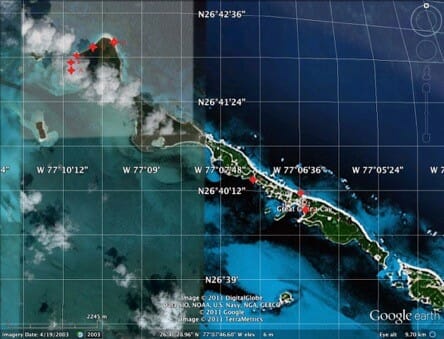
Algae were studied all around Guana Cay, including the Bakers Bay development (upper left) and near the fishing village (lower right)
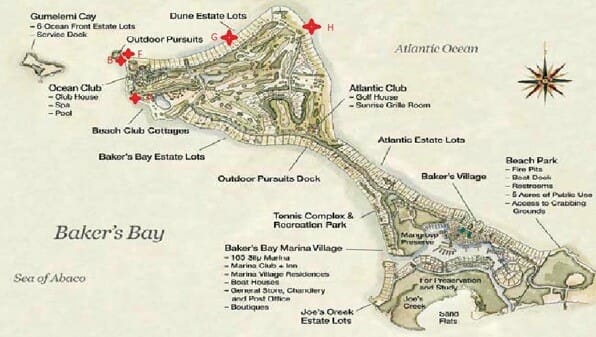
Algae were sampled along the coast on beachrock around the golf course
Algae nearest the golf course green had highest nitrogen concentrations, derived from nitrate flowing through the groundwater into the sea. Most phosphorus was adsorbed by the limestone and did not reach the water. The nitrogen content of algae nearest the golf course had isotope ratios indicating highest levels of sewage nitrogen, while nitrogen in algae further away was of natural origin (decomposition of vegetation, etc.). The organic fertilizer used on the golf course, Milorganite, is made from processed human sewage by the city of Milwaukee. These data (below) clearly indicated that the harmful algae blooms were caused by golf course fertilizers.
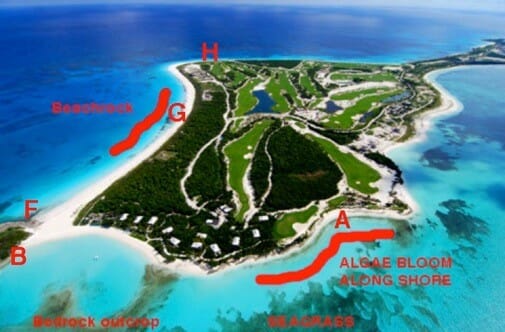
Northwest Guana Cay from the air. The algae bloom off the golf course closest to the shore is the brown fringe right along the shore at A. The dark patch in the algae bloom area is due to algae growing directly on the sand in front of the beach where fertilizer runoff leaches into the water. Dark areas at bottom left are eroded limestone rock with relatively little algae, dark areas along the upper left beach (G) are beachrock, with some algae but much less than the bloom area, dark patches offshore at upper left are coral reefs undergoing coral disease outbreaks, and dark patches at lower right and right are seagrass beds. The letters show near shore algae sampling sites
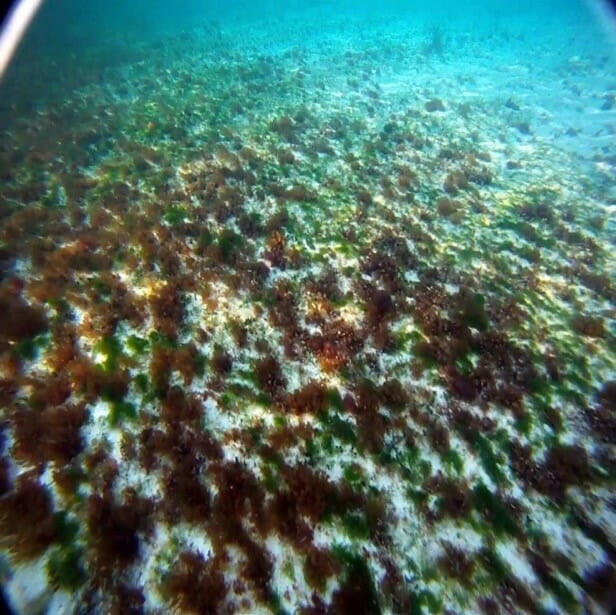
High nutrient-indicating algae smother the bottom nearest the golf course (lower left) and decrease away from it (upper right)
The developers first denied that there were any algae at the site (false), then they said they were natural and had always been there (false), then they said that the algae had been caused by a recent hurricane (false because hurricanes remove algae and no algae appeared at other shores around the island after the hurricane), and finally they claimed that the algae next to the golf course were not caused by nutrients from the golf course, hotel and villa sewage, or the marina, but came from sewage pollution from local residents at the opposite end of the island (false because algae nitrogen isotopes at the village end showed their nitrogen sources were natural, not from sewage, and algae color there indicated lower nutrients).
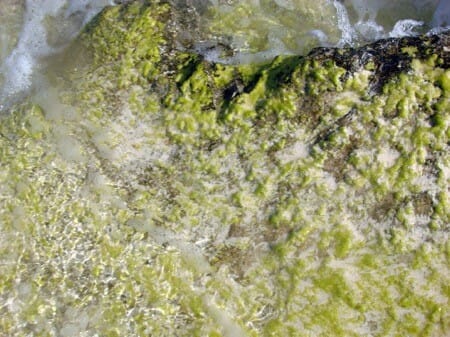
Algae in the Guana Cay harbor next to the village are pale and have low nutrients
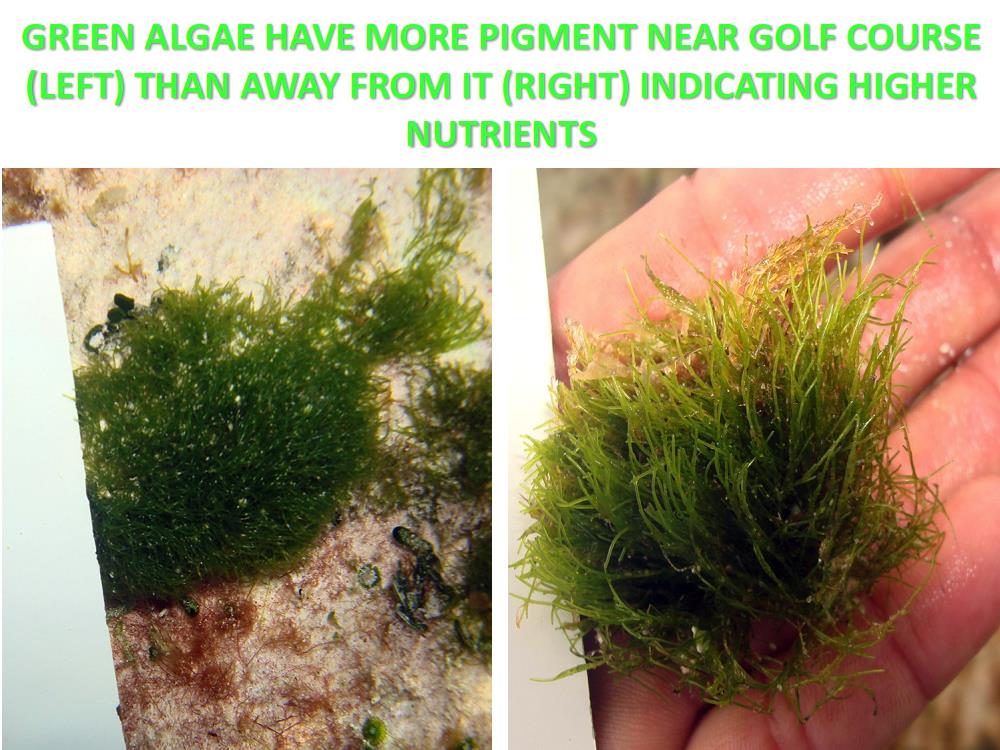
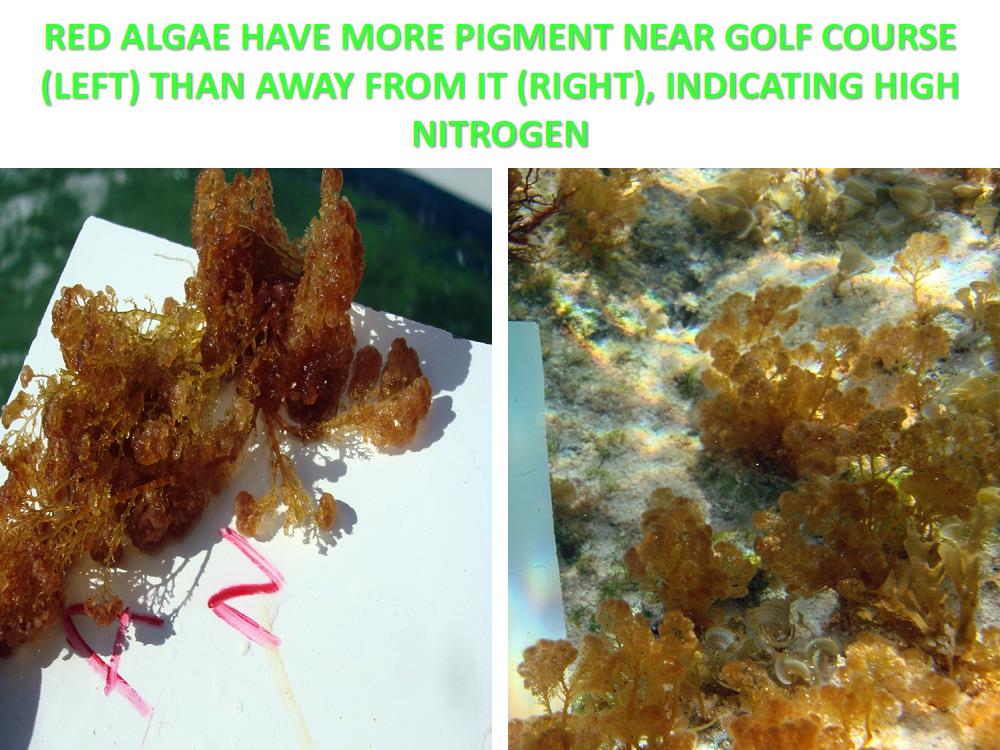
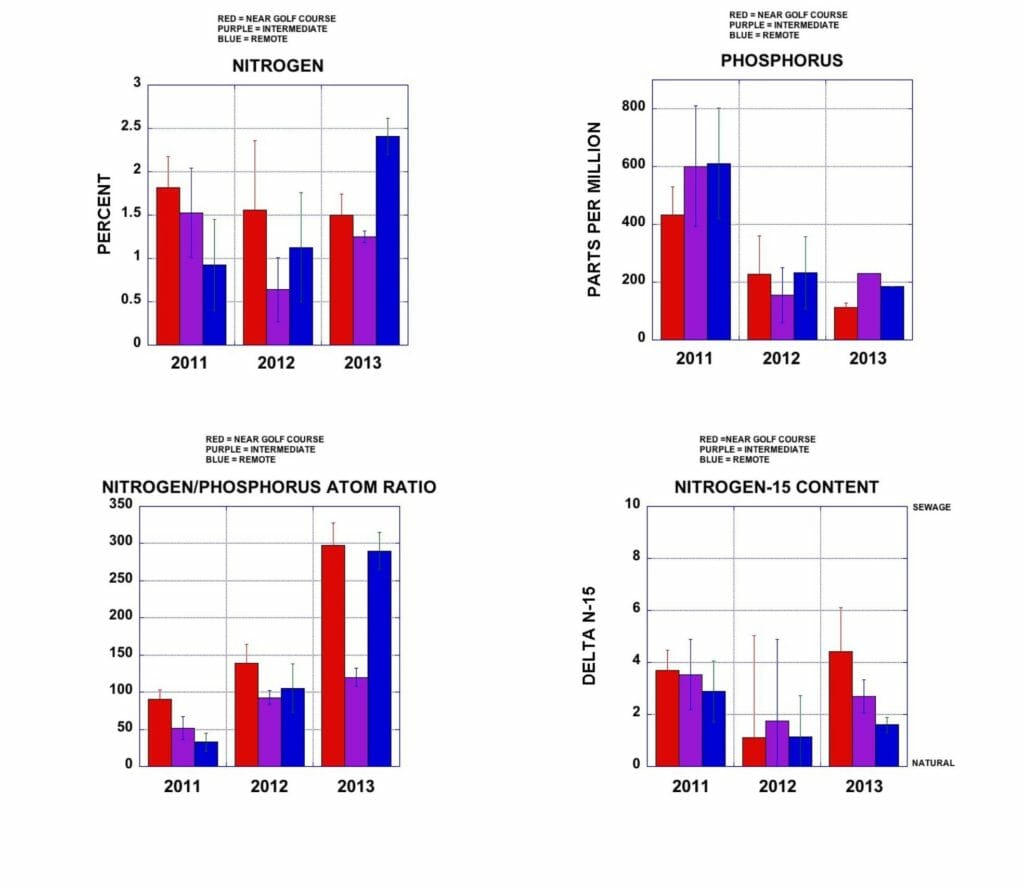
Analyses of algae found that those nearest the golf course had elevated levels of nitrogen of sewage and fertilizer origin, while those furthest away had the most natural nitrogen
Conclusions
In conclusion, the Bakers Bay Golf Course, Marina, Resort, and Villa development destroyed the ecological function of pristine Bahamian coral reefs, mangroves, and sea grasses that were crucial and essential nursery habitat for lobsters, conch, and fishes, devastating the fisheries resources of a community that had lived from them since the 1700s. Similar results are expected at other coastal developments, but had never been looked for.
Credits
Photos by Fritz Goreau, Thomas F. Goreau, Thomas J. F. Goreau, Troy Albury, James Cervino, Christopher Hartley, & Save Guana Cay Reef.
About the author:
The author collected algae for scientific researchers as a child in Jamaica, and has dived in most Caribbean countries over nearly 65 years, looking at the ecology of the corals and algae. His grandfather and father photographed Bahamian coral reefs in 1948. He has studied the reefs of Guana Cay, Abaco, Bahamas since 2007. Some of his relevant publications include:
T. J. Goreau, 1992, Bleaching and reef community change in Jamaica: 1951-1991, in Symposium On Long Term Dynamics Of Cora Reefs, American Zoologist, 32: 683-695
T. J. Goreau & K. Thacker, 1994, Coral Reefs, sewage, and water quality standards, Proc. 3d. Caribbean Water And Watewater Association Conference, Water And Wastewater Needs For The Caribbean: 21st Century, Kingston, Jamaica, 3:98-116
T. J. Goreau, L. Daley, S. Ciappara, J. Brown, S. Bourke, & K. Thacker, 1997, Community-based whole-watershed and coastal zone management in Jamaica, Proc. 8Tth International Coral Reef Symposium 2:2093-2096
T. Goreau, 2003, Waste Nutrients: Impacts on coastal coral reefs and fisheries, and abatement via land recycling, 28p., United Nations Expert Meeting On Waste Management In Small Island Developing States, Havana, Cuba
T. Goreau, 2009, Integrated nutrient management of coastal waters and watersheds, 10p., in T. J. Goreau & S. T. Nielsen (Eds.), The Green Disc: New Technologies for a New Future, Gibby Media Group, Spokane WA
A. DeGeorges, B. Reilly, & T. Goreau, 2010, Land-sourced pollution with an emphasis on domestic sewage: Lessons from the Caribbean and implications for coastal development on Indian Ocean and Pacific coral reefs, Sustainability, 2: 2919-2949
T. J. Goreau, 2020, Covid Halts dolphin pollution in Discovery Bay, Jamaica, Global Coral Reef Alliance